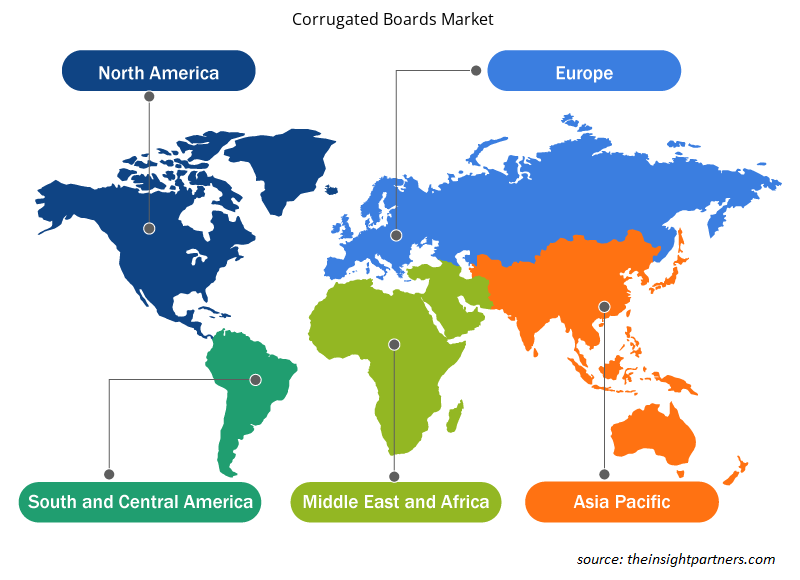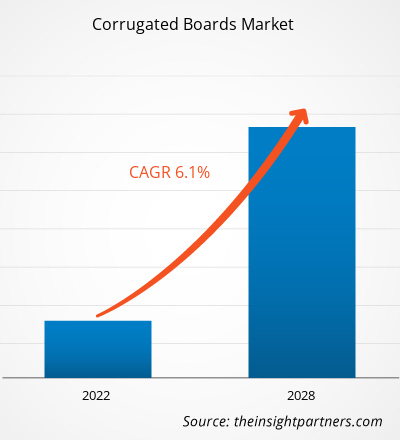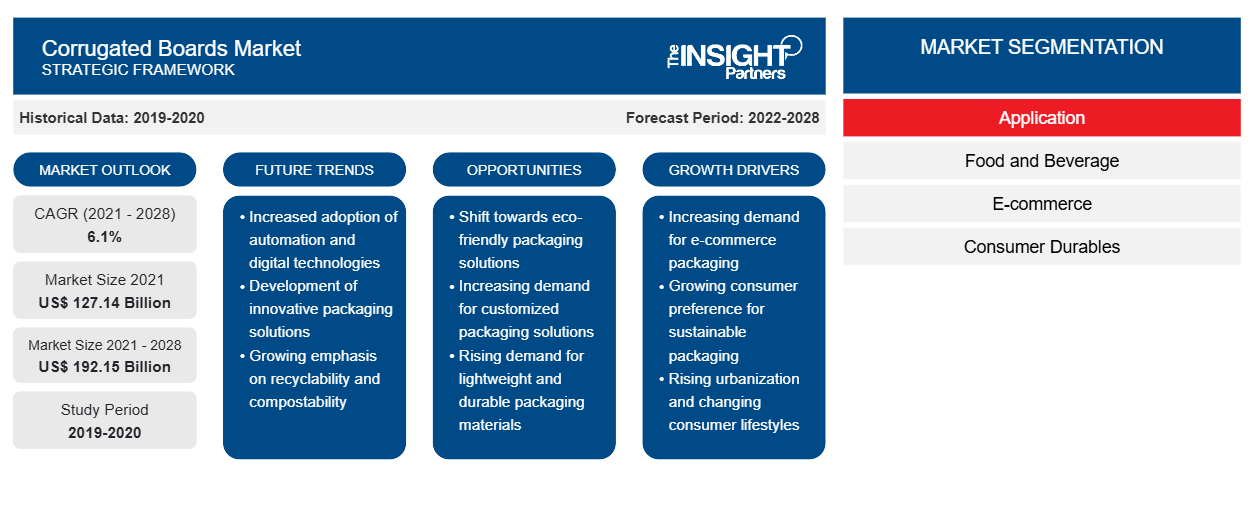[Rapporto di ricerca] Il mercato del cartone ondulato è stato valutato a 127.139,07 milioni di dollari nel 2021 e si prevede che raggiungerà 192.153,31 milioni di dollari entro il 2028; si prevede che crescerà a un CAGR del 6,1% dal 2021 al 2028.
L'imballaggio ondulato riguarda l'imballaggio di vari beni, come prodotti alimentari e bevande, beni di consumo durevoli, elettronica ed elettrodomestici, in scatole di cartone ondulato per il trasporto secondario. L'uso del cartone ondulato per l'imballaggio è una tecnica di imballaggio conveniente e adattabile per proteggere, conservare e trasportare una varietà di articoli. I cartoni ondulati sono adatti per l'applicazione in una varietà di settori, come alimenti e bevande, beni di consumo durevoli, prodotti elettrici ed elettronici, carta, prodotti chimici, prodotti per la cura della persona e per la casa, agricoltura, silvicoltura, pesca e prodotti in plastica e gomma.
Nel 2020, l'Asia-Pacifico ha detenuto la quota maggiore del mercato globale dei cartoni ondulati e si stima che registrerà il CAGR più elevato nel mercato durante il periodo di previsione. Nell'Asia-Pacifico, c'è stato un aumento del consumo di cartoni ondulati in vari settori, come alimenti e bevande, elettronica ed e-commerce. L'aumento della consapevolezza riguardo alle soluzioni di imballaggio in cartone ondulato sostenibili ed economiche, che vengono utilizzate nel trasporto dei prodotti, e varie iniziative del governo per vietare gli imballaggi in plastica in diversi paesi asiatici aumenterebbero la domanda di cartoni ondulati nella regione nei prossimi anni. Inoltre, un aumento della consapevolezza sull'ambiente spinge la domanda di soluzioni di imballaggio più ecologiche, che sta guidando la crescita del mercato dei cartoni ondulati. Inoltre, l'aumento della domanda di prodotti elettronici, parti di automobili, prodotti per la casa e prodotti di bellezza e cura della persona dai mercati nazionali e internazionali sta alimentando la domanda di scatole di cartone ondulato, guidando così la crescita del mercato del cartone ondulato. Il settore dell'e-commerce sta crescendo a un ritmo rapido nella regione. Uno dei principali rivenditori di e-commerce, Amazon, sta utilizzando scatole di cartone ondulato per l'imballaggio principale e si affida a imballaggi in plastica per singoli articoli nell'area Asia-Pacifico. In Thailandia, le crescenti preoccupazioni relative ai rifiuti di imballaggio probabilmente costringeranno il governo a emanare normative che spingano i cittadini ad adottare opzioni ecosostenibili, come scatole pieghevoli o scatole di cartone ondulato, come scelta praticabile per l'imballaggio, il che fornirebbe opportunità di crescita per il mercato del cartone ondulato nella regione durante il periodo di previsione.
Personalizza questo report in base alle tue esigenze
Riceverai la personalizzazione gratuita di qualsiasi report, comprese parti di questo report, o analisi a livello nazionale, pacchetto dati Excel, oltre a usufruire di grandi offerte e sconti per start-up e università
-
Scopri le principali tendenze di mercato in questo rapporto.Questo campione GRATUITO includerà analisi di dati che spaziano dalle tendenze di mercato alle stime e alle previsioni.
Impatto della pandemia di COVID-19 sul mercato dei cartoni ondulati
Molti settori, come l'industria chimica e dei materiali, hanno dovuto affrontare sfide senza precedenti a causa della pandemia di COVID-19. L'implementazione dei protocolli di sicurezza COVID-19 ha portato alla carenza di materie prime e manodopera, alla chiusura delle fabbriche e ad altre difficoltà operative. Pertanto, le aziende coinvolte nella produzione di prodotti per imballaggio hanno dovuto affrontare una contrazione delle vendite durante i primi mesi della pandemia. Il settore dell'e-commerce ha assistito a una domanda significativa di vari prodotti, come alimenti e bevande confezionati, generi alimentari, beni di prima necessità quotidiani, beni di consumo durevoli, a causa della chiusura dei negozi offline. Con il settore dell'e-commerce in rapida crescita, anche durante la pandemia di COVID-19, c'era una domanda significativa di cartoni ondulati dal settore dell'e-commerce per imballare e trasferire vari beni. Tuttavia, a causa della carenza di materie prime e della chiusura delle unità produttive a causa dei lunghi lockdown a livello nazionale, c'è stato un enorme divario tra domanda e offerta, che ha avuto un impatto negativo sulla crescita del mercato dei cartoni ondulati. Inoltre, a causa del rallentamento delle operazioni logistiche, il settore dell'imballaggio ha dovuto affrontare una perdita significativa.
Le aziende stanno guadagnando terreno man mano che i governi di vari paesi allentano le restrizioni imposte in precedenza. Inoltre, l'introduzione del vaccino COVID-19 ha allentato la situazione, portando a un aumento delle attività commerciali in tutto il mondo. Inoltre, le aziende di logistica coinvolte nel trasporto di beni essenziali quotidiani e prodotti alimentari e bevande hanno spinto la domanda di cartone ondulato. Pertanto, si prevede che il mercato globale del cartone ondulato crescerà in modo significativo nei prossimi anni. La pandemia di COVID-19 ha stimolato lo sviluppo del settore dell'e-commerce. Ha dato ai clienti l'accesso a un'ampia gamma di prodotti, come beni essenziali, prodotti di largo consumo e beni di sicurezza. Ha inoltre consentito alle aziende di continuare a operare nonostante le limitazioni e le restrizioni imposte a varie attività industriali e di trasporto. Il settore dell'e-commerce ha contribuito in modo significativo alla ripresa delle operazioni logistiche, che, a loro volta, dovrebbero rafforzare la crescita del mercato del cartone ondulato nei prossimi anni.
Approfondimenti di mercato
Rapida espansione del commercio al dettaglio online
Le piattaforme di e-commerce hanno acquisito un notevole slancio in tutto il mondo grazie ai crescenti investimenti delle aziende nell'espansione della loro portata geografica attraverso diversi canali di distribuzione, insieme alla crescita del settore industriale. Di conseguenza, le consegne dirette al consumatore sono aumentate di 20 volte o più rispetto alla distribuzione standard. Inoltre, i rivenditori online hanno registrato una crescita significativa negli ultimi anni grazie alle innovazioni tecnologiche, che hanno spinto la domanda di prodotti di imballaggio in cartone ondulato. La pandemia di COVID-19 ha aggravato la crescita della vendita al dettaglio online a causa del distanziamento sociale imposto nei luoghi pubblici e delle restrizioni emanate sulla conduzione del commercio faccia a faccia. Secondo un articolo pubblicato da The Rio Times a marzo 2021, i ricavi generati dai canali di distribuzione dell'e-commerce sono aumentati del 41% nel 2020, con oltre 194 milioni di ordini effettuati dai consumatori brasiliani nell'anno. Questa è considerata la percentuale di aumento più alta registrata in Brasile dal 2007. Secondo Eurostat, il 70% della popolazione europea era composta da acquirenti online nel 2020, rispetto al 60% del 2016. Pertanto, la crescita del settore dell'e-commerce spinge la domanda di soluzioni di imballaggio avanzate, come i cartoni ondulati, in tutto il mondo.
Approfondimenti sulle applicazioni
In base all'applicazione, il mercato dei cartoni ondulati è segmentato in alimenti e bevande, e-commerce, beni di consumo durevoli, elettricità ed elettronica e altri. Il segmento degli alimenti e delle bevande ha rappresentato la quota di mercato maggiore nel 2020, mentre si prevede che il segmento dell'e-commerce registrerà il CAGR più elevato nel mercato durante il periodo di previsione. Nel settore alimentare e delle bevande, i cartoni ondulati sono frequentemente utilizzati nell'imballaggio e nel trasporto di vari prodotti alimentari. Sono utilizzati per produrre cartoni e scatole che offrono un'imbottitura solida durante il trasporto e la movimentazione di vari articoli, come frutta e verdura fresca, prodotti a base di carne, uova e prodotti da forno, e sono una delle opzioni di imballaggio più sicure e igieniche disponibili sul mercato. I cartoni ondulati sono puliti e igienici poiché sono prodotti ad alte temperature. I cartoni mantengono livelli di umidità ottimali e impediscono la crescita dei batteri, rendendoli ideali per la spedizione di alimenti deperibili. Si prevede che questo fattore alimenterà la domanda di cartoni ondulati da parte del settore degli imballaggi per alimenti e bevande nei prossimi anni.
Alcuni attori che operano nel mercato del cartone ondulato sono IRANI PAPEL E EMBALAGEM SA; Puffo Kappa; Klabin SA; Compagnia WestRock; Carta internazionale; Arcore; Klingele Papierwerke GmbH & Co. KG; Papeles y Conversiones de Messico; Mondi; e NIPPON PAPER INDUSTRIES CO., LTD.
Approfondimenti regionali sul mercato dei cartoni ondulati
Le tendenze regionali e i fattori che influenzano il mercato dei cartoni ondulati durante il periodo di previsione sono stati ampiamente spiegati dagli analisti di Insight Partners. Questa sezione discute anche i segmenti e la geografia del mercato dei cartoni ondulati in Nord America, Europa, Asia Pacifico, Medio Oriente e Africa e America centrale e meridionale.

- Ottieni i dati specifici regionali per il mercato dei cartoni ondulati
Ambito del rapporto sul mercato dei cartoni ondulati
| Attributo del report | Dettagli |
|---|---|
| Dimensioni del mercato nel 2021 | 127,14 miliardi di dollari USA |
| Dimensioni del mercato entro il 2028 | 192,15 miliardi di dollari USA |
| CAGR globale (2021 - 2028) | 6,1% |
| Dati storici | 2019-2020 |
| Periodo di previsione | 2022-2028 |
| Segmenti coperti |
Per applicazione
|
| Regioni e Paesi coperti |
America del Nord
|
| Leader di mercato e profili aziendali chiave |
|
Densità degli attori del mercato dei cartoni ondulati: comprendere il suo impatto sulle dinamiche aziendali
Il mercato del cartone ondulato sta crescendo rapidamente, spinto dalla crescente domanda degli utenti finali dovuta a fattori quali l'evoluzione delle preferenze dei consumatori, i progressi tecnologici e una maggiore consapevolezza dei vantaggi del prodotto. Con l'aumento della domanda, le aziende stanno ampliando le loro offerte, innovando per soddisfare le esigenze dei consumatori e capitalizzando sulle tendenze emergenti, il che alimenta ulteriormente la crescita del mercato.
La densità degli operatori di mercato si riferisce alla distribuzione di aziende o società che operano in un particolare mercato o settore. Indica quanti concorrenti (operatori di mercato) sono presenti in un dato spazio di mercato in relazione alle sue dimensioni o al valore di mercato totale.
Le principali aziende che operano nel mercato del cartone ondulato sono:
- IRANI PAPEL E EMBALAGEM SA
- Smurfit Kappa
- Klabin SA
- Azienda WestRock
- Carta internazionale
Disclaimer : le aziende elencate sopra non sono classificate secondo un ordine particolare.

- Ottieni una panoramica dei principali attori del mercato dei cartoni ondulati
Segnala i riflettori
- Tendenze industriali progressive nel mercato del cartone ondulato per aiutare gli operatori a sviluppare strategie efficaci a lungo termine
- Strategie di crescita aziendale adottate dai mercati sviluppati e in via di sviluppo
- Analisi quantitativa del mercato del cartone ondulato dal 2019 al 2028
- Stima della domanda globale di cartone ondulato
- Analisi delle cinque forze di Porter per illustrare l'efficacia degli acquirenti e dei fornitori che operano nel settore
- Sviluppi recenti per comprendere lo scenario competitivo del mercato
- Tendenze e prospettive del mercato, nonché fattori che guidano e frenano la crescita del mercato del cartone ondulato
- Assistenza nel processo decisionale evidenziando le strategie di mercato che sostengono l'interesse commerciale, portando alla crescita del mercato
- La dimensione del mercato dei cartoni ondulati in vari nodi
- Panoramica dettagliata e segmentazione del mercato, nonché dinamiche del settore dei cartoni ondulati
- Dimensioni del mercato del cartone ondulato in diverse regioni con promettenti opportunità di crescita
Mercato dei cartoni ondulati – per applicazione
- Cibo e bevande
- Commercio elettronico
- Beni di consumo durevoli
- Elettrico ed elettronico
- Altri
Profili aziendali
- IRANI PAPEL E EMBALAGEM SA
- Smurfit Kappa
- Klabin SA
- Azienda WestRock
- Carta internazionale
- Arcore
- Klingele Papierwerke GmbH & Co. KG
- Papeles y Conversiones de México
- Mondi
- NIPPON PAPER INDUSTRIES CO., LTD.
- Analisi storica (2 anni), anno base, previsione (7 anni) con CAGR
- Analisi PEST e SWOT
- Valore/volume delle dimensioni del mercato - Globale, Regionale, Nazionale
- Industria e panorama competitivo
- Set di dati Excel
Report recenti
Testimonianze
Motivo dell'acquisto
- Processo decisionale informato
- Comprensione delle dinamiche di mercato
- Analisi competitiva
- Analisi dei clienti
- Previsioni di mercato
- Mitigazione del rischio
- Pianificazione strategica
- Giustificazione degli investimenti
- Identificazione dei mercati emergenti
- Miglioramento delle strategie di marketing
- Aumento dell'efficienza operativa
- Allineamento alle tendenze normative























 Ottieni un campione gratuito per - Mercato del cartone ondulato
Ottieni un campione gratuito per - Mercato del cartone ondulato